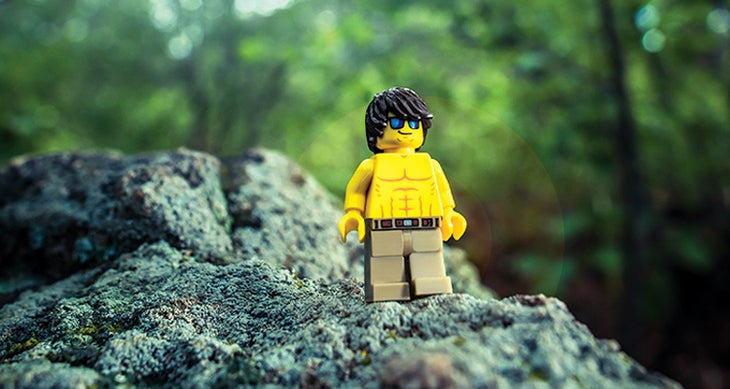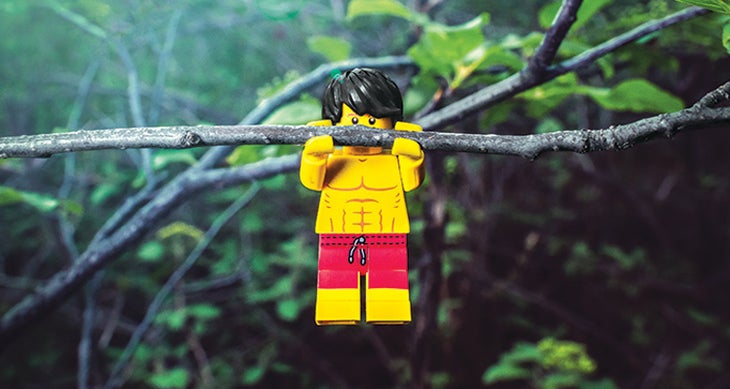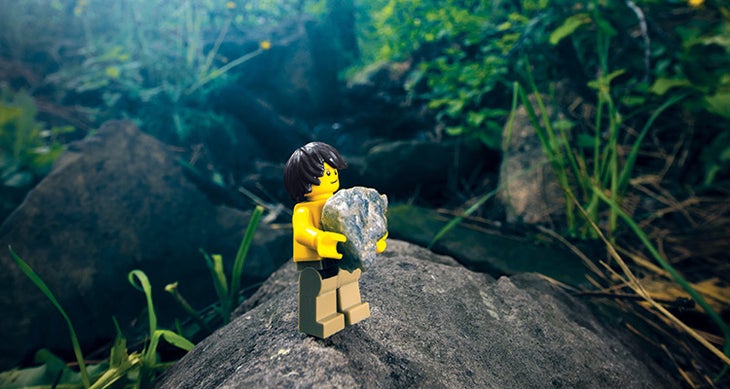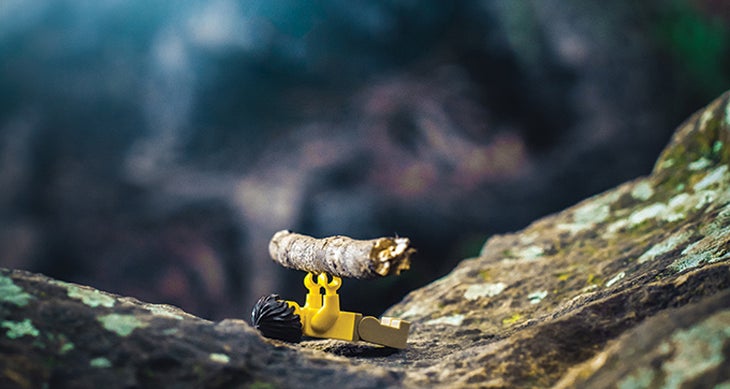Heading out the door? Read this article on the new Outside+ app available now on iOS devices for members! Download the app.

Call me Jesus Christ SuperCrunch.
I’m running barefoot just outside of Olympic National Park’s Hoh Rainforest, gripping a long stick behind my back with both hands and forcing my chest out. Besides being hard, it looks a little too much like a crucifix for my liking. There’s even a spectator wearing a handmade leather tunic. He has roots tattooed on his bare feet.
“There’s one thing I’m not seeing from you,” he booms in a huge voice. He forks his fingers and pushes at the corners of his mouth to reveal a toothy grin beneath his foot-long ivory beard. “You should be smiiiiling.”
Easy for him to say. But then I see what he’s seeing: a 5’10”, 175-pound man, shirt soaked through with sweat, prancing about the woods twirling branches. I can’t help but smile at that. Mick Dodge, the Barefoot Sensei, National Geographic reality TV star, mountain man of Washington’s Olympics, and today, my trainer, is right.
I’m relieved to be enjoying this, kind of. Because in the decade or so that I’ve cared about fitness, I’ve become the world’s foremost expert on what I hate about working out. And it’s not what you might think. I am not some sloth. I enjoy sweating, I like pain. But the gym itself? Shudder. The unspoken primate competition, the sickly fluorescent lighting, the constant funk of salty undies, and the grunting, so much grunting. The only thing gyms pump me up with is the desire to get the hell out of there and into the woods. On top of that, I have no tolerance for monotony. Once the novelty goes out of a workout, it’s a short trip back to my hazy-lazy seesaw between casual running, a few odd pushups, and, inevitably, nothing at all.
Never mind, I tell myself, hiking keeps me in shape for hiking. After all, it’s gotten me up Rainier and across big routes all over the world. But in the last year (I’m 35), on a group climb up the Golden Horn in the North Cascades, my fitness plateau started to feel like a slanted pitch. At the summit, I panted like a black dog in summertime. Didn’t this used to be easier? Was I going soft?
Then I knew it was time. If I can reach for best-shape-of-my-life outdoor performance now, maybe I can write it into my muscle fibers and preserve it until I can’t put one foot in front of the other. I’m not looking for modest gains, or even simple gut erasure. I want to be a straight-up beast. I want panting, sweaty guides to fall three switchbacks behind. I want to explode my shirt Hulk Hogan-style, and when people ask me, “What’s your secret?” I want to blow their minds when I casually answer, “Backpacking.”
But, how? I know I can’t commit to a gym routine without pulling the ripcord a few weeks in. I need something that will make the workouts an end unto themselves, not just a suffer-through to get the fitness I want. So, really, I’m looking for the perfect workout—something that’ll sustain my mind as it punishes my body.
Which is why I’m in Mick’s woods— or, as he calls the forest, Earthgym. It’s packed with such exquisite exercise props as boulders, sticks, rushing rivers, and 200-foot-tall trees that shade the muddy trails leading from glacier to sea. If this is the gym, I think, sign me up.

Ask anyone what pops into his head when he thinks “workout” and he’ll probably say “gym.”
Traditional gyms are heavy on convenience, but for a lot of people, light on results—probably because our brains aren’t built to derive satisfaction from such a place.
Science has my back on this one: Numerous studies published by the National Institute of Health and others show adults who exercise outdoors go at it 30 minutes longer, on average, than those who work out inside. They also have an easier time staying committed to their routines (versus indoors, where half of new gym goers quit in less than a year). Plus, the mere act of moving outside relieves stress and lowers blood pressure, resting heart rate, and cortisol in the bloodstream.
“We evolved to be outside,” says Joan Morrell, a neuroscientist at Rutgers University who studies the link between exercise habit and motivation. “For some of us [the gym] is already a somewhat aversive environment.”
There are plenty of workout programs that take place outdoors, but I’m not so sure parking lots, athletic fields, or stadium stairs are what Morrell has in mind.
Turns out scientists aren’t the only ones to notice the training boost from the great outdoors: Loose collectives like Dodge’s Earthgym and Dan Vinson’s Wild Gym preach a brand-new, CrossFit-by-way-of-wilderness workout method that blends long trail miles, ultralight hiking, and strength training using the surrounding ecosystem.
In between shooting his show, Dodge offers in-person instruction ($150 and up) around the country in wilderness hot spots like Tahoe and the Olympics. He started 20 years ago, but now acolytes lead Earthgym classes where students take off their shoes and heft stones in places as civilized as New Jersey. Wild Gym mostly teaches corporate clients how to go primal for an hour a day (individual sessions start at $25), but it’s trying to crack the mainstream with its Monkii Bars—basically, twin batons that anyone can hang from trees or rocks to make outdoor bodyweight exercises easier, more fun, and even more punishing (see review below). Both offer free instructions on YouTube to get warriors like me started.
While they remain fringe groups for now, the growing popularity of similar programs like MovNat and an appetite for paleo-everything means I might not be the only one hauling logs at the trailhead before long.
Both outfits preach a fitness strategy that summons your inner Australopithecus, but they take markedly different approaches. Wild Gym prescribes a more traditional do-this-for-this-long strategy—which sounds a little regimented for my taste. As for Earthgym, well, Dodge isn’t so concerned with metrics, duration, or what you might call measurable progress— which sounds a bit woo-woo. I decide to try them both, Wild Gym first.
If my plan works, it’ll be a training strategy any backpacker would covet: lifelong fitness, powered by trail time.

Three days after Christmas, I meet Wild Gym’s Dan Vinson
outside in Nederland, Colorado, a mountain enclave above Boulder. It’s -4°F in town, but we’re planning on climbing 1,600 feet higher into the snowy Indian Peaks Wilderness. With sunrise pinking the foothills and my coffee going lukewarm, I am less than psyched.
Not Vinson, who drives the Tarzan-in-trail-runners look home with a wild chestnut mane that billows around his face, and lats that spread his t-shirt like the wings of a manta ray. He beams, he bellows, “Are you ready to get WILD?” I’ve heard such overambitious enthusiasm at the gym before, usually right after a heavy stack of weights hits the floor and right before I start looking for the door. But Vinson’s enthusiasm erases my misgivings—rather than riding the stoke of competition, he seems generally pumped on helping people tap into the endless font of fitness and self-esteem that surrounds them.
His origin story might explain that: After being cut from Georgetown University’s lacrosse team his freshman year for being too soft, Vinson retreated to a backcountry ranger job in the Sierra. With nothing but miles of trail and the rocks and trees around him, he transformed the mountains into a gym and made the team the next year. Since then, he’s refined his wilderness training techniques—bodyweight exercises and interval training integrated into trail time— during five years as a wildland ranger in California and a firefighter in Montana.
I wonder if this stumble and redemption is what makes Vinson meet me at my level. On the drive to the trailhead, we trade favorite hikes and stories, and I realize Vinson is just like me, only built like Wolverine. Screw the whipping winds: I am ready to get wild.
Over the course of a single-day boot- camp designed to teach me the basics, Vinson introduces me to his methods: Do what you love, and add a layer of bodyweight, interval, and core training to supercharge your days. “Hiking and backpacking already create a baseline of longterm health and fitness,” he says. “All you need to do is pour gasoline on the fire.”
We clomp 6 miles into the Indian Peaks, breaking trail through 2 feet of fresh snow in spots. I’m in snowshoes, Vinson on skis. I congratulate myself for keeping up until we get to his favorite workout spot: a tall, gnarled ponderosa at the crest of a rocky pass. There’s a gorgeous panorama of snow-swept peaks—better than any 24 Hour Fitness wall of mirrors—but it’s also a nozzle for 40-mph winds roaring over the Continental Divide. Here’s where we’ll try out Vinson’s Monkii Bars.
By now it’s warmed up to 70F, but the wind makes it feel like -170. Time to get wild: lightning rounds of jumping pull-ups, squats, and hanging knee-to-chest raises—at over 10,000 feet—7 reps, 7 sets of each, no breaks.
I’m huffing but holding my own until my grip starts to weaken somewhere late in the fifth set. I fall to my knees a few times. Vinson barks encouragement over the wind (“Gas on the fire!”), and I finally finish in a forever-feeling 6:58. My chest is twitching in new and scary ways—it feels like I spent an hour doing bench presses. I could get used to this.
That’s if I survive a Tabata run uphill in the snow, which Vinson prescribes for the second part of the day. Tabatas are short bursts of intense exercise—like intervals on PCP. Today, that’s running full-tilt for 20 seconds, followed by 10 seconds of walking, followed by 20 seconds of maximum speed running—until I puke or collapse. Repeat eight times for a total of four minutes of punishment.
As soon as the timer beeps, Vinson is nipping at my heels, whipping me up the snowy slope and counting down in my ear.
By my third interval, I’m sucking wind; by the fifth I feel like I have a plastic bag over my head. I taste battery acid; not throwing up is a victory. After four minutes it feels like jellyfish are swimming through my leg veins. I start a dry cough that lasts for hours. “That’s because the cilia in your lungs are dried out,” Vinson says with an air of triumph.
I can barely move the next day, but the exhilaration sticks with me. Over the next few days, as the soreness fades, I’m left with two questions: Will I be able to do this if Vinson isn’t personally driving me? And how am I supposed to integrate this deep-wilderness workout in a city, where I live?
But I got a good thwacking and an exercise routine that felt like something new. Time to sample Mick Dodge’s heady goods.

If you want to know what it’s like to be someone, walk a mile in his shoes. If you want to know what it’s like to Mick Dodge, take your shoes off and dance around like a wood nymph.
Dodge’s outdoor bonafides scare me a little. On our first phone call, he had to call me back because he was “warming up” from a swim in the ice-blue Sol Duc River. In November.Sheets of rain pelt the cedar walls of Dodge’s cabin, near Washington’s Hoh Rainforest. I count no less than 12 dogs outside who stop playing in the mud circle and greet me. Inside, antique rifles and knives decorate the walls.
“I started hiding my weights in the Olympics; I’d run and go up for training sessions for three days,” he says in a warm, storyteller’s growl. “Then I started turning Earth into a gym. I got into a trance. I emptied my cup, remembered climbing back up into the trees. I began to relax my body, started accepting animals as my teachers: cougars, banana slugs; river otters move with tremendous fluidity through the water.”
“Follow your feet and the Earth will teach,” is Dodge’s guiding principle. At his behest, I pulled off the road on my way here and asked Lake Crescent for permission to enter and learn. Under my breath, sure, but I did it. Hiking shoeless I’m even more skeptical of.
But Dodge is sure enough for the both of us. The former Marine and heavy equipment mechanic has been walking across his native Washington’s rainforests his whole life, and doing it barefoot since 1981. He developed his idea for Earthgym while on barefoot walkabouts (some as long as four months) in the Olympics and Cascades over the last several years.
“I would camp out not too far from my job, and on the weekend I would pick a direction—say, 97 degrees—and I would jump fences, sneak through private property, and go until I couldn’t go any farther,” he says.
“You’re restoring your feet with the land. We have a primal body memory in us that’s millions of years old, and the less I have with me—walls, machines, electronics—the more I can stimulate that and get back into the land.”
The rest of his primitive workout method has four simple tools: stick, stone, sack, and rope.
First, we gotta get out there.
My shoe-loving, city-soft feet are tentative at first, so I pad along soft dirt and sodden moss with a mid-foot strike and grip the ground with my toes. Pokey sticks and rocks send wiggles up my back and make me look more like a guy tentatively entering the ocean than the powerful Sasquatch of my imagination.
And then, slowly, I start to loosen up.
Going barefoot becomes less painful; the nerves in my toes send little pulses that make transitioning from soft moss to gravel or bare rock easier by slowing my stride or shifting my weight. During a weight-lifting session where we heft round granite stones, it gets real: When barefoot, I can feel my feet grip and my core tense to lift a rock overhead. Up to my knees in ferns, I can feel my muscles ripple from soles to fingertips while shafts of sunlight slice the mist between the firs. This is what I’m after.
The rest—twirling rope pullups, hanging upside down and spinning until my head pops, swinging a sack full of rocks like I’m trying to kill a troll—passes by in a blur of amorphous play. Climbing trees, running in the snow, pretending you’re an otter? It’s kind of a blast.
But of course it has the same problem as Wild Gym: How do I bring this kind of fitness-as-fun workout to the city, where 90 percent of my training takes place?
I ask Dodge about my dilemma. Though he presents as a mountain-man relic who sleeps in trees and eats grubs, he shares my goal of finding a way to make the mystical lessons of the Hoh thrive in the city. “The city is where squirrels train—but they’re not diabetic,” he says. “Start by getting away from walls and machines. Take what you know from the indoor movement disciplines—yoga, gyms— and just take it [outside].”
I can do that. I think.
Reconciling the teachings of my two coaches to the city, then, is my biggest challenge. What’s more, I’ll try it in Seattle’s dark and damp winter, when most trails are under feet of snow. But I think I’ve cracked the code.
Dodge’s push to “go questing” leads me to barefoot-run on sidewalks. When I get bruises, I switch to yards and medians, which makes me feel like a weirdo creeper when security floodlights expose me. But things improve when I stop trying to force it and look for a middle way: Sometimes I wear shoes, sometimes I don’t. I look for the places in between, cracks in the sidewalk where wildness sprouts in the city. I try to let whimsy inform my approach, and I start discovering things: gnarled trees perfect for pull-ups or climbing, hidden city park paths quiet as any mountain trail.
But I start noticing real changes when I incorporate Vinson’s detailed Wild Gym plans. Incremental progress becomes exponential as I increase the length of my interval sprints, the number of burpees, pull-ups, or V-outs I can do from the big-leafed maples that crown a punishing hill in a nearby city park. I’m jumping belt notches, and hidden obliques start to wink at me as the pounds drop off. Instead of dreading the workout, I get hooked: on fresh air charring my lungs to a crisp, the feel of dirt wedging into my nails, cold rain pouring on me while I’m burning inside, maxed out and panting.
And then I hit that most common of walls: life. Work hours, social obligations, and the attendant distractions pinch my workout time down to two days a week, then one. I’m getting pushed off the pillar I’d worked for. I need a fix—and fast—but I can’t figure out what’s wrong.
And then, I do. I’d gotten into exercising outside, but I’ve been missing the big dose of wilderness that’s core to both teachers’ methods. I can’t get out into the deep wilderness every time I’m due for a workout. But then I realize: I’m a backpacker. I just need to take my workout with me on my next trek.
I pack my Monkii Bars on a big backpacking trip and take my gym on the trail. It’s here that I realize that enjoying the wilderness is the iron core of my ideal fitness routine. Whether I’m hefting stones by a glacial creek or doing rows under midday sun, the exercise is just the frisson that pushes me to the next level—the gas on the fire. Like Vinson says, being wild at heart is the key.
Now, back to being wild in the city.
This is when I finally stumble on athletic alchemy that lasts.
Vinson’s concrete goals give me something I can win, a finish line to point my muscles toward. Dodge’s charmed third eyesight helps me spot the nature and wonder in my city, to chase crows and drop whatever doesn’t make me smile.
The twinned approaches explode on the weekends, where overnights and dayhikes in my usual outdoor cathedrals become playground challenges. I take both the good vibes and the performance gains back with me to town, which helps me work through the drab sessions when I might otherwise want to take the day off.
And it’s working.
One morning, on a run up Sentinel Mountain in Missoula, Montana, I keep pace with a pack of twenty-something runners in Griz tees. As we reach a nest of switchbacks, I sprint past them and go off-trail, breaking through tangled firs until I find a meadow studded in flowers. Sunlight hits remnant snow on the rounded peaks beyond. In this quiet spot, I work my muscles until they quit, and ice them with the lingering chill in the air.
I’m starting to love my new gym.
Ted Alvarez, BACKPACKER’S Northwest Field Editor, is definitely not responsible for the uptick in Sasquatch sightings around his Washington haunts.
Your Turn
Slip the surly bonds of the city and go primal on a trail near you. No matter where you live, we’ve got a hike with your name on it. It’s up to you to turn that into your own personal gym. Get started with our zipcode-based hike finder at backpacker.com.
Gear
Monkii Bars
Turning the wilderness into your gym requires no equipment—but a pair of Monkii Bars means never having to worry about finding the perfect branch or rock to support your weight. Simple bamboo batons connected by Spectra cord, the bars attach to any load-bearing object and enable the user to perform dozens of exercises— from classics like dips to body-crushing Vinson originals like monkiimakers (see monkiibars.com/learn/monkii-movements for an intro). Aerial suspension makes for mean balance training; pushups and dips get harder but work your core, too. The durable cord never broke, but the ends did cosmetically fray after being scraped for months over bark and stone. The hook-and-eye fastener takes a bit of practice to get the hang of, and if you aren’t paying attention it’s easy to get the cord tangled on branches or legs, or knotted on itself. But at only about a pound, they offer a lightweight solution for nearly limitless wilderness training. A door adapter ($20) means you can use them at home, too. $149; monkiibars.com
Gas on the Fire
Already hike and backpack regularly? Good news: You’re halfway there. Integrating these high-intensity workouts from Wild Gym into your trail time will build muscle, jump-start fitness, and shatter plateaus.
Add the exercises below to a hike—or simply do them outside. Warm up with 5 minutes of jogging and three sets of eight of the following: squats, pushups, situps, back extensions, and lunges. For rows, V-outs, and flys (see right for definitions), you’ll need a long piece of webbing or rope with loops at the end for grips (also good for harder hanging pull-up moves) or a lightweight gear assist (such as Monkii Bars).
EASY
A) 3 pull-ups
B) 20 lunges
C) 5 knees-to-chest
For the first minute, complete 3 pull-ups and rest the remainder of the minute. For the second minute, complete 20 lunges and rest the remainder. For the third minute, complete 5 hanging knees-to-chest and rest the remainder of the minute. Repeat this process for 12 minutes total.
Run 3 miles at moderate pace.
MEDIUM
PART A Complete a 7-minute circuit of the following: 5 push-ups, 7 rows, 9 squats.
Cycle through the exercises as as many times as possible in 7 minutes. Rest for 3 minutes.
PART B Complete four sets of five V-outs with perfect form.
PART C Tabata hill sprints. Find a hill and complete 8 rounds of the following: Run for 20 seconds at max pace; rest for 10 seconds. Repeat.
HARD
PART A Five rounds of 7 push-ups and 20 Russian twists. Complete the rounds as fast
as possible, making sure to fully lock out arms for each pushup rep.
PART B Focusing on form and not speed, complete four sets of six reps of flys and reverse flys. Quality of movement is paramount.
PART C Heavy Packout Load up a multiday pack with 5 to 10 percent more weight than you’d carry on
an average trip. Hike or run as far and as hard as you can in one hour. Bonus challenge: Try hiking at max pace for 35 minutes and attempt to return in 25 minutes.
Glossary
V-outs With webbing loops or Monkii Bars hanging at chest level, lean forward and push your arms out in a V shape, balancing on the balls of your feet. Keep your arms straight. Retract and repeat.
Russian twists Sit on the ground with hips bent at 90 degrees (your back should be at a 45-degree angle). Gripping a stone, weight, or short log, extend your arms out and rotate as far as you can left, and then as far as you can right, in one twisting motion. That’s one rep.
Rows Grip webbing loops, or parallel branches at about chest height and lean back on your heels until arms are fully extended, keeping legs and back straight. With your shoulder blades tight and under control, pull yourself up.
Flys With Monkii Bars at knee height and shoulder- width apart, lean on them in pushup position. Slowly spread your arms wide, lowering your chest to even with the bars, and return.
Reverse flys With webbing straps at chin level, grip the loops and lean back so your arms are extended and your back and legs are straight and
at an angle to the ground. Slowly spread your arms wide to lift your chest up to bar level. Return to starting position. That’s one.
